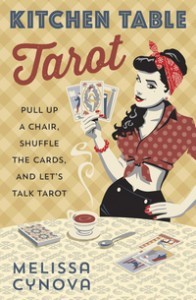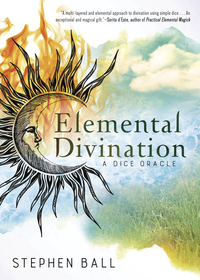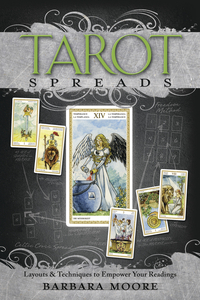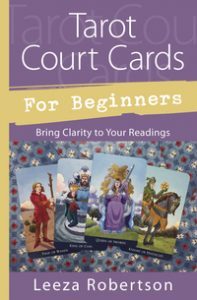Llewellyn Publications's Blog, page 39
March 21, 2018
Sass and Insight

Melissa Cynova’s Kitchen Table Tarot is known for its straight talk and insight. Cynova tells it like it is, with sass, compassion, and clarity. In addition to interpretations for each individual cards, she also provides an understanding of what each group of numbered cards means. That is, she explains what Aces, 2s, 3s, etc. mean in general. This is a great way for beginners to start to learn the cards. By looking at them in groups, it breaks down learning meanings into smaller chunks. Start by learning the numbers…there are only ten of them. That is much less daunting than jumping into learning all forty of the numbered cards. This creates a sketch of the tarot structure, which makes it easier to fill in the details for each individual cards because you can see how they all fit together.
For example, here is what she says about the 6s:
We look at the laurels that decorate the Six of Wands and then to the charity witnessed in the pentacles. We see the understanding that one needs to move to safety, as the sworsd urge us to do, and the moving backward to innocence in the cups. The sixes are all about recognition. Whether being recognized for your successes, seeing your place in the world, folding yester-you into present you, or finding a new home, the sixes want you to be aware of where you are, what you have around your, and what you need to do next. They are present-oriented cards.
March 20, 2018
Today is International Astrology Day!
Today is International Astrology Day!
Considered by many to be the start of the astrological new year, International Astrology Day is celebrated each year on the Spring Equinox (the day the Sun enters Aries).
There are various observances around the world, including lectures and other events.
Anyone have any plans to celebrate this observance?
(PS: We’re celebrating with a sale…feel free to join in our celebration!)

March 19, 2018
Perceiving a Crazy World in a Very Sane Way
Readers, please enjoy this guest blog post by Robert Kopecky, author of the new How to Get to Heaven (Without Really Dying).

This is a crazy world, where crazy things happen all the time. It can be very difficult. In fact, sometimes it seems like it’s too messed up to ever straighten itself out…but then again it may be fine, just as it is. It’s possible the craziness just grows out of the way we look at it. Perhaps we needlessly suffer from a matter of simple misperception.
Being human means taking part in an unavoidably persistent set of illusions that we’ve all bumped into at one time or another. A lot of the time, nothing seems magical at all, but how else can we explain that amazing, magical things really happen quite frequently? Let’s start by rebooting our perception with this fundamentally magical fact:
We are floating around an infinite galactic cosmos on a tiny planet, spinning in limitless space.
If you think about it, that alone can change your day.
Being humans from Earth, naturally our little human minds—our “Small Mind”—wants us to believe everything it says is true. It wants us to believe the spontaneous thoughts that tell us “life is difficult,” and “amazing things are not likely to ever happen.” It wants us to believe that we’re separate little individual organisms, independent and unattached—but that’s silly, isn’t it? Just look at the world. We’re obviously much, much more than that.
The truth is that we’re all essentially one incredibly magical, completely and irrevocably interconnected thing! We’re the seamless energy of Life, riding around in human bodies (for the time being). Like every living creature, we’re personal packages of Divine Being-ness. Right away that takes some weight off our shoulders, doesn’t it?
I had the mixed fortune of surviving multiple “Near-Deaths,” the first being in the classic “out-of body” motif. I looked down on my crash and saw my own apparently lifeless body—and believe me—it’s hard to get the genie back in the bottle after that. Stop for just this moment, and imagine being there with me.
Imagine yourself outside of your own body, being your pure energetic self—unencumbered by the insistent demands of your limited human mind. When you identify yourself at the level where your inner self and the rest of the universe are one—seamlessly unified—the crazy problems and obstacles of “life on Earth” suddenly hold very little power.
With this simple, reimagined perception of Life, you can immediately gain an expanded, coolly tolerant and empathetic experience of Consciousness—as shared by all. It’s easy to accept the crazy world (and all the crazy people), just as it is. Freed from confining demands and expectations, everything is simply part of the whole, expressing that Divine Consciousness however it has to.
You engage in our “Big Mind”—a condition that’s also called “Buddha Mind,” or “Christ Consciousness.” That’s not such bad company to keep, is it? And for as long as you can stay there, you’ll never have to misperceive this crazy world again.
Our thanks to Robert for his guest post! For more from Robert Kopecky, read his article “What Did 3 Near-Death Experiences Teach Me About Heaven?.”
March 12, 2018
A Dice Oracle Reading for the Coming Month
Readers, please enjoy this guest blog post by Stephen Ball, author of the new ELEMENTAL DIVINATION.
Many readers today use cards such as the tarot for divination, but dice oracles also have a long and rich history worldwide. We have records of dice being used for foretelling at some of the most important sites in ancient Greece, all the way through to medieval times and the present day.  .
.
Here is a dice oracle reading for advice on how we should approach the next month. It uses the oracle published as Elemental Divination: A Dice Oracle, which gives readers a system bringing together the magical correspondences of Air, Fire, Water, Earth, the Sun, and Moon into a full system of divination.
Lesser Earth over Fire: “Wood for the Fire Pit.”
This is actually one of the most comforting and supportive readings. The Fire here is of a medium strength, and Earth is coming into the situation in small, useful amounts as wood. Fire can be dangerous when it rages out of control, but it is also a great help to us—it cooks food and heats the house, provides light in the darkness, and makes our home welcoming in the evening. That is what we see here.
The magical correspondences of the elements give us even more aspects to this reading. Fire brings great energy and movement, determination to make changes, and passionate beliefs. Earth gives security, providing heavy rock and resilient protection, as well as a grounding influence on the emotions to settle disagreements. It even adds to home life with nourishment gained from food, fresh green plants, and good shelter.
In the combination we have here, Earth has come in but has not replaced the existing Fire (because it is only of Lesser strength). If the elements or amounts were different, then the meanings would change completely: Earth could have brought enough weight of soil or rock to put out the Fire, or the Fire could be blazing and unstoppable. That doesn’t happen here, though, which gives us the clue to the bigger meaning for the coming month. The message is, “if we feed our basic needs then our Fire will not go out.”
There are many challenges facing us this year, but if we look after ourselves with food, sleep, and a solid foundation, then this will fuel our Fire to be brighter, even when there is a storm outside. Earth’s heavy inertia won’t be enough to slow us down, and Fire’s bright optimism will push us ahead us into new adventures! Take the time to look after your basic needs, and you will be able to surge forward to pursue the goals about which you feel most strongly.
Our thanks to Stephen for his guest post! For more from Stephen Ball, read his article, “What Exactly Is a Dice Oracle?“
March 7, 2018
Everybody’s Different
Adapted from Your Tarot Your Way

As we know, different people will feel differently in the same situation. That is, at a large party full of witty conversation and high energy, introverts will feel overwhelmed and extraverts will feel stimulated and happy.
One of the great skills in reading tarot is seeing how the energy of various cards works together to create a story. Court cards represent people, so we can learn more about court cards in general and gain practice reading energy interaction with this simple activity.
Separate your court cards from the rest of the deck. Shuffle the rest of the deck and lay them out as below…except leave the position of Card 1 – Significator empty.
Take your Court card pile and pick one card (randomly or select one that you are interested in) and place it in the Card 1 position.
Instead of trying to interpret the cards as a reading, look at the energy of the cards (using both your intuitive and analytical skills). How does that card feel in the situation? Then take that court card out and put another court card in its place. How does that change the feel of the reading? This is a great activity because it helps you practice reading cards in relation to each other and also recognizing that what might be a great situation for one person may be another person’s dread.
6
3 1/2 4
5
1: Significator.
2: The challenge in this situation.
3: The energy from the past that is affecting the present.
4: The energy in the future that can be put to use.
5: The root of the situation.
6: Your best hopes or goal in this situation.
February 21, 2018
True Magic Tarot Spread
Most of the time, I create tarot spreads for specific questions. Sometimes, though, I am inspired by a quote, a particular card, or even a whole deck. Anything can provide inspiration for spread creation. Here is how a deck inspired me and the resulting spread.
From Tarot Spreads: Layouts & Techniques to Empower Your Readings

True Magic Spread
A few years ago, I did some writing for an Italian. Each magazine came with a tarot deck and part of my job was to create spreads that were inspired by the deck. Here’s an example; it is called the True Magic Spread and was created for The Sorcerer’s Tarot.
6
4 5
1 2 3
The Sorcerers Tarot explores the realm of magic, which is really a part of all things and within each of us. The deck’s premise is that as children, we seem to intuitively understand magic and how to use it. As we grow up, obligations, logic, and other priorities create a wall between magic and us. The Sorcerers Tarot is meant to help us connect, again, to our magical abilities.
While children have a natural connection with magic, anyone, who wishes to become more skilled at seeing and using magic can do so. In the cards of this deck, many of the young magicians wear pointed hats. These pointed hats represent a magical practice known as the Cone of Power. The Cone of Power is when a magician raises magical energy and directs it according to his will. Is this metaphoric or real? You will have to determine that for yourself. In either case, the concept makes for an interesting spread.
You can use the True Magic Spread to look at any situation or question with magical eyes. It can help you see what you may have missed and discover some “magical” ideas.
What you have: The energy or resources that you have, whether or not you realize it.
What you need: Energy or a resource that will benefit the situation. You should make an effort to acquire it.
Who will help: This is someone who can help you. They may be right under your nose, so don’t overlook anyone’s value.
What to do: This is an action you should take to increase the power or benefit of the energy or resources represented in cards 1 – 3.
What not to do: This is something that your non-magical self thinks is a good idea, but that your magical self knows will be counter-productive in the situation.
Outcome: If all the advice in this reading is followed, this is the best likely outcome. Whether positive or negative, find the magic in it.
The bottom row of the spread, cards 1 – 3, represent the gathering of energy (or resources), which is the first step in creating a Cone of Power. The second row, cards 4 and 5, focus on how to increase and amplify the energy. The top card, card 6, shows what happens if this energy is manifested.
February 19, 2018
Why We Must Feed Our Mojo
Readers, please enjoy this guest blog post by Chas Bogan, author of the new Secret Keys of Conjure.
 There are all manner of physical items that we may build a magical relationship with, such as roots whose indwelling spirits we have engaged for aid, or metal charms stamped out in factories, or mojo hands that some perceive as being an extension of their own body and magical will. Though the life force present within such objects may be perceived in many ways, keeping it healthy is essential to maintaining an effective charm. The responsibility falls on us to sustain and nurture our magical allies. If you won’t work on their behalf, why should they continue to work for yours? Even the most loyal and loving of pets, if starved of attention and sustenance, may turn.
There are all manner of physical items that we may build a magical relationship with, such as roots whose indwelling spirits we have engaged for aid, or metal charms stamped out in factories, or mojo hands that some perceive as being an extension of their own body and magical will. Though the life force present within such objects may be perceived in many ways, keeping it healthy is essential to maintaining an effective charm. The responsibility falls on us to sustain and nurture our magical allies. If you won’t work on their behalf, why should they continue to work for yours? Even the most loyal and loving of pets, if starved of attention and sustenance, may turn.
Perhaps because such things as our magical jewelry and ceremonial wands do not jump on our sleeping chest and yowl as our pet cat might, we tend to forget that they must also be tended to. Of course, not everything is by nature needy, as such things that are made of metal have dwelled inert within stone for ages and may not have the needs as, say, a root having given up its prospect of sun-touched leaves to become an ally on a magician’s altar. Listening to those entities that serve as our magical allies is important for understanding what their needs are.
When I make a mojo bag for someone, I always impress upon them the importance of keeping it fed. This is done by applying alcohol or cologne to it, at least once a week. I tend to give them a specific day of the week to work with, which I choose to be aligned with the purpose of their bag, for instance, for love charms I favor Fridays for its association with Venus the goddess of love. As for what type of cologne, the choices vary. There are commercial brands that have a long history of traditional use, such as Hoyt’s Cologne and Florida Water. Whiskey is the most common alcohol used, though I might get fancy and use something like Goldschlager—which contains the traditional money-drawing ingredients of cinnamon and gold leaf—to feed a mojo whose purpose was to draw money. Other magical items might have other wants, such as how lodestones crave iron shavings, or your flute the breath from your mouth. Whatever their needs may be, it is important to understand how their strength and health leads to our own.
The saddest thing is when our magic is left to die like a forgotten bathroom fern. I have been guilty of this myself, having on occasion cleaned out a drawer or old backpack to find some magical item whose life force was dulled by dust. A bath in morning dew or night spent bathed in moonlight can often be the trick to reinvigorating them, but maintaining a regular schedule of care is by far preferred.
Our thanks to Chas for his guest post! For more from Chas Bogan, read his article, “5 Conjure Fixes for Ridding Yourself of Negative Influences.”
February 15, 2018
“Fur-ever” Love
Readers, please enjoy this guest blog post by Kristy Robinett, author of Messenger Between Worlds, Forevermore, It’s a Wonderful Afterlife, Messages from a Wonderful Afterlife, the new Tails from the Wonderful Afterlife, and the forthcoming Journey to the Afterlife.

Most have lost a loved one. There is typically a standard grieving process, which may come with several days off at their job, flowers, cards, and compassion. There is often a funeral or memorial service where there’s time to give and receive support and love, and moments to say a goodbye to their deceased.
Losing a pet is difficult, too, but it rarely comes with the same end-of-life formalities, which can cause unresolved or delayed grief. The fish might be flushed down the toilet with a goodbye, the hamster put in a shoe box and buried in the back garden. Some pets are left for the veterinarian to dispose of; in the last couple of decades, there are has been a rise in alternatives such a cremation and pet cemeteries. Even still, it’s hardly the same as how we treat our human loved ones, yet I’ve found that many people mourn their pet more than they do some of their family members. I’ve also discovered that many want the reassurance that their pets is still with them in spirit and happy in the afterlife.
Being that our pets don’t communicate the way humans do, often there is uncertainty.
“Did I do right by her?
“Could I have done more?”
I feel like I let him down.
“Is she upset with me?
These are all questions that sound asked to by a human about a human. They are, however, common questions asked about their pet regarding their last days/weeks, spirit transition, and afterlife.
One of the many reasons we love our pets so much is that they rarely hold a grudge, or at least for long. Have you ever stepped on your pet’s foot or tail? They howl for a second and the next moment they are looking for your attention. Unlike humans, they give us love unconditionally, and that same love continues forever.
Losing a beloved pet is one of the most difficult things to experience, but the unconditional love between you and your pet continues into the afterlife. Tails from the Wonderful Afterlife shares heartwarming and amazing stories of the signs, symbols, and messages that our pets send to us, proving that they are waiting and even helping us from the other side. From near-death experiences to witness accounts to life-saving tails―pun intended―you will both cry and laugh as you discover an array of animals and their heavenly hellos. This comforting book also offers suggestions for dealing with grief and guidance on how to make the connection with your deceased companion.
Our thanks to Kristy for her guest post! For more from Kristy Robinett, read her article “5 Ways Your Stuff Is Keeping You Stuck.”
February 7, 2018
Traditional Court Card Names

Many people think that the court cards of tarot are antiquated and no longer relevant to modern people. They may be right, but for some reason even when deck designers rename and re-imagine them, people usually revert back to the traditional names. For example, when using a deck with a court card called Seeker of Air, they will use the traditional card name in addition to or even instead of the name given by the creator, in this case, Knight of Swords.
For better or worse, we can’t seem to release these names from another time. If we can’t let them go, perhaps we’d do better to try to understand them more deeply.
In Tarot Court Cards for Beginners, Leeza Robertson gives exercises to help us build understanding.
For example, she urges us to explore Chivalry and the knightly code:
When one hears the word “chivalry,” images of knights on white horses riding in to save fair maidens tend to come to mind. Yet this simplistic romantic notion of chivalry is a bit off the mark in relation to what it meant to the knights of the medieval period. Chivalry was a much more complex ideology with many moving parts; rescuing fair maidens was never actually mentioned. In the Rules for a Knight, author Ethan Hawke introduces us to the code of conduct that forms this ideology. This list was handed down by one of his ancestors, who was an actual knight in the British royal court.
The twenty rules are as follows:
Solitude
Humility
Gratitude
Pride
Cooperation
Friendship
Forgiveness
Honesty
Courage
Grace
Patience
Justice
Generosity
Discipline
Dedication
Speech
Faith
Love
Death
Robertson then suggests:
Look at the list and pick one attribute to focus on for the day. You could do this for a week or even a month, if you wanted. For now, observe how making one of these your deliberate point of focus changes your day.
Let’s say you choose to focus on pride. Where does pride stop being ego-based and start being spirit-based? How do you show pride in yourself and those around you? What does pride even mean to you?
February 5, 2018
The Unwanted Gift (And What To Do About It)
Readers, please enjoy this guest blog post by Tisha Morris, author of Decorating with the Five Elements of Feng Shui and the new Clutter Intervention.

It’s that time of year, when the Christmas lights are stored away, our post-holiday diet is underway, and resolutions are made. But what about the…Unwanted Gift? Whether it is Christmas, birthday, or some other occasion, we all get an uneasy feeling when we unwrap the fruitcake, the ceramic yard ornament, or fringed elbow-padded sweater, and have to pull off our best improv performance.
In Christian tradition, the idea of gift exchange was inspired by the presents given to Jesus by the Wise Men. Prior to that, it was done to bring good fortune back to oneself just prior to the New Year—a token of good karma of sorts. And in Jewish customs, it was a benevolent intent of giving money to the poor.
But somehow over time we’ve gone from frankincense, gold, and myrrh to Obligation, Consumerism, and Projection. And the joys of wondering what Santa will bring is now, “What am I going to be stuck with from the office party?”
Regardless of the occasion, an unwanted gift brings up a lot of anxiety when it comes to decluttering. It can trigger self-worth, lack, guilt, and shame. All of that over a piece of macramé? Yes.
The excuse we use is that we don’t want to hurt the other person’s feelings. But I’m going to challenge you: It’s actually you avoiding your own feelings.
For most people, receiving is more difficult than giving because it triggers our self-worth. Rarely are we concerned with what people do with gifts we give, just the gifts we receive. When we give a gift, we feel good about it and move on. When we receive a gift, however, it triggers our self-worth, especially if we don’t like it—because now our guilt consciousness is also triggered.
Not only was receiving this gift hard, but now I’m wanting to get rid of it. What kind of person am I?
What if she finds out I got rid of it? She’ll think I’m not a good friend. That would be horrible. I am horrible.
He’ll think I’m ungrateful and a selfish person. I probably am ungrateful and selfish.
These are some of the conversations we have with ourselves, consciously or unconsciously. Notice the exact words in the story you tell yourself. It will give you clues to what’s really at the root of your beliefs about yourself (i.e. Ungrateful, Selfish, Disloyal, Horrible).
This will also be indicative of underlying emotions within the relationship between the gift giver and gift receiver. Rarely do we have a problem getting rid of a gift from someone where there’s no karma at play.
When self-worth wounds are triggered, a domino effect of boundary issues in our life begins. Having items in our home that we don’t like or want represents a boundary we’ve allowed to be crossed.
Most of us grew up with our boundaries or preferences violated, and thus this feels familiar. What our parents provided for us was our definition of being taken care of and therefore what we perceived as love. We got used to others’ preferences being imposed upon us. Resisting them led to shame, so we learned to give in and put a smile on our face. You may have heard language like, “You need to be grateful for what you get,” or, “Beggars can’t be choosers,” or, “Tell Grandma how much you love the gift.”
So, what to do with these items? Stuffing them in the closet is the same as stuffing guilt. At the same time, displaying an unwanted item is a boundary crossing. The only answer is to get rid of unwanted gifts. If this feels too extreme right away, then pledge to keep the item for one year and then give it away in a manner that feels honoring to the item and the person.
Be mindful of what gifts you give people, and if you have expectations or conditions with which you are giving the gift. Give gifts you think the person truly wants, not what you want for them. Be non-attached from there. Give unconditionally.
If you’re unsure what someone wants, then give an intangible gift such as a service, an experience, something consumable, or a gift card. Or, there’s always the reliable frankincense, gold, and myrrh.
Our thanks to Tisha for her guest post! For more from Tisha Morris, read his article “5 Ways Your Stuff Is Keeping You Stuck.”
Llewellyn Publications's Blog
- Llewellyn Publications's profile
- 243 followers



